

Anchor Selection Manson vs Rocna - Gemini 105
| December 2007 - I had been reading my friend Paul's log about anchoring in the Bahamas. He had trouble setting the Bruce, now on our boat, several times and when we were on the boat to make the "deal" to purchase Freedom, we drug. Therefore, I decided that we would go with one of the new technology anchors to add to our insurance policy. Setting a Bruce in weeds is next to impossible and I find the Delta looks too close to a plow used to furrow fields even though it has the "wings" bent out. Therefore we were off on a quest to decide between the Manson and the Rocna. In our investigation, I read everything I could, including the Sail anchor tests, and talked to owners. The Rocna, appeared to have some differences that for a liveaboard might be worth the price differential. Ultimately, I elected to purchase the Rocna 15 kg or 33 pound anchor. In the pictures and text below, I hope I can explain the differences that I saw. While I was in Fort Lauderdale, I took pictures of the Manson anchor and then I took pictures of the Rocna when it arrived for us in Marathon. The first series of pictures shows some similarities. They both have a roll bar and they both they both have a steel arm which comes up for the chain to attach to. However, on the right, you can see that there is a hole in the back of the Rocna to attach the line and float when you are anchoring so you can pull it out if it gets stuck. In addition, there is a hole on the bottom of the arm for attaching another anchor in series in case of a BIG storm. Of course here you start to get a picture of the back of the anchor which is different too. |
|
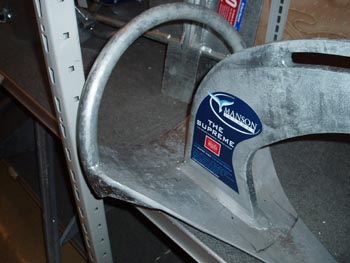 |
|
| Something you might just notice the difference between the arm size between the Manson and the Rocna. I don't thing the Manson would have actually fit on my boat without modifying it slightly. | |
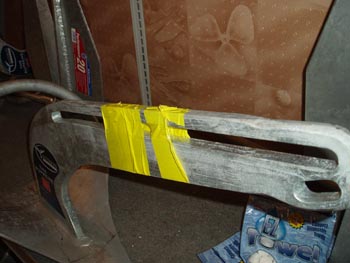 |
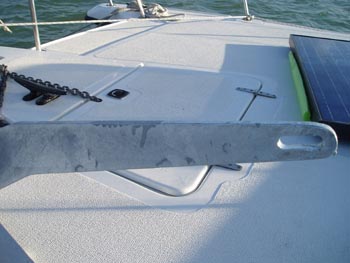 |
| The edge of the anchors are also different. It appears the Manson has a secondary piece of metal which goes half way to the shaft, while the Rocna's secondary piece of metal goes 2/3rds back and connects with the angled down piece that ultimately connects to the roll bar. | |
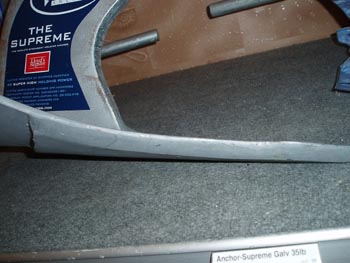 |
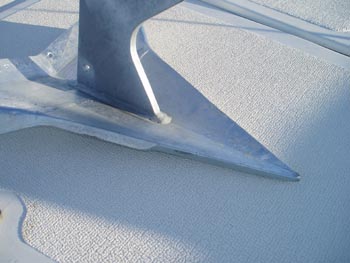 |
| This picture is one of the main reasons that I purchased the Rocna. The Manson, left, is straight on the back while the Rocna is bent up. To me, this means that it will grab more in a softer situation. That of course is my opinion but it is why I spent the extra $150 bucks. Rocna's literature will say that the angles are very important on the bend and therefore the curved shape doesn't work as well as the angled shape. I have no clue but I do like the back piece. In some ways it is like the delta that uses the angles bent on the side of the plow. | |
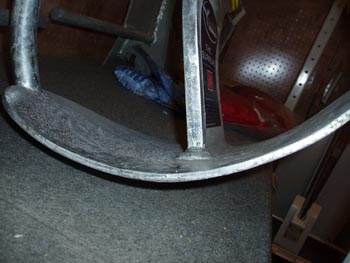 |
 |
The picture on the left shows the difference between my Bruce and the Rocna. It becomes easy to see that the Rocna will set faster than the Bruce and it is also clear that the Rocna will drive deeper into the soil. The picture to the right shows the Rocna on its side which is probably where it will end up when dropped and that is the position it is intended to be in. The point is down and should drive straight into the soil, sand, weeds or whatever. |
|
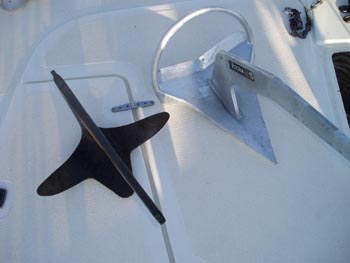 |
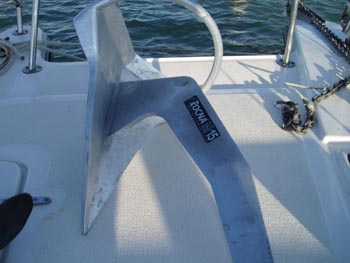 |
The RC Boats pictures below show the anchor on the bow. I have a Gemini 105M which is hull number 536. Newer Gemini's have a slot which the anchor comes through. The look of the anchor arm is the same as a delta and as you can see, it fits very well and tight. In addition, based on information on the Gemini List serve, someone tested this anchor on a new Gemini and it also fit. I am currently in Marathon on a mooring ball waiting for paperwork and then a weather window to the Bahamas. It actually may be the Bahamas before we actually test it. I also want to point out a few other things. I am using high test 1/4 inch chain. Working load 3,150 pounds and breaking load is 9450 pounds. The rode is 1/2 inch nylon with a breaking strength of 7,500 pounds. Next is the thing I believe most people take for granted. The shackle. If you check the strengths of standard anchor shackles such as a stainless steel 5/16th shackle then you will find the strength is 1,500 pounds. Oops, that will break before you ever get to the pressure of an 80 knot wind. I now have an anchor tested to 5,000 pounds, a chain with breaking strength well above that, a rode that is above the anchor capability. However, since it is used, it is more in the range of 5,000 to 6,000 pounds. Now I need a shackle that will give me similar strength. Therefore I got off the anchor shackle page and went to the Wichard Shackle information and picked out a 13/32 pin diameter shackle which fits the 1/4 inch high test chain and it has a safe working load of 4,190 pounds. The model number is Wichard 1205. Now I have a complete system that should hold up. If I were to upgrade anything next, it would be the rode and move to 5/8ths. |
|
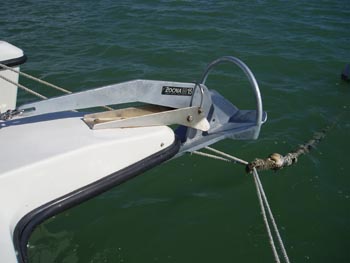 |
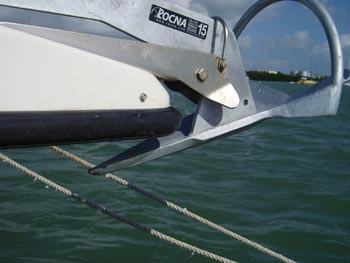 |
When we were in the Bahamas, I took a number of pictures of the anchor set. This one is typical. It didn't matter if it was grass, partial grass, or just sand. It always set. On top of that, you better not be going back too quickly when you are setting the anchor in reverse or you will get whiplash. It sets great and then you can run the reverse up to whatever you want, slowly, to finish the set. We typically go up to 2,000 rpm and then have our anchor wine. We watch people drag all the time right past our position and have to say, the Rocna decision was wonderful. |
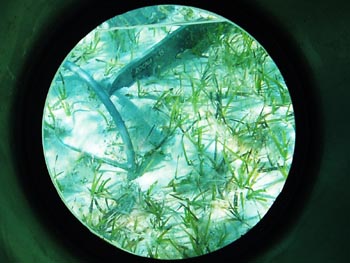 |
Dec 16, 07 update - I had some questions as to how long my chain was and how I attached it to a bridle. The 1/4 inch high test chain is 60 feet long. I chose the length because I typically anchor in 6-8 feet of water and this would provide me a good length of chain for a minimum of 6 to 1 scope. If I'm in 8 feet or less of water, I use the chain hook you see to the right to connect the chain to the ring. If I'm in deeper water, then I bring the rode as a loop through the steel circular loop you see to the right and then wrap it three times around the wooden "bone" to keep it from pulling through. The loose end of the rode then gets attached loosely to the anchor cleat. The two lines you see are about 15 feet long each and they hook to the cleats on each side of the forward hull. In the end, I have an effective length of line that is a little over 10 feet longer than the chain I have out. (Later update - We changed the lines on that steel ring with 1/2 inch line and thimbles. Also, we had to put on a new board but it all works wonderfully.) |
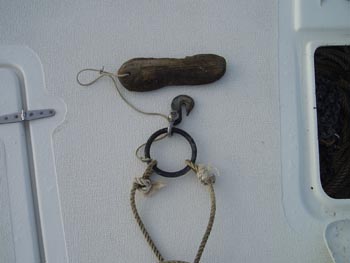 |
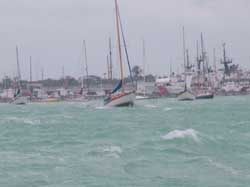 |
Why worry about all of this? You can see a picture of the anchorage at Key West during our stay for the winter of 06/07. Boats were dragging a breaking loose all over. Agreed, this wasn't a big storm, with winds around 35-40 knots. In Key West, you are in an open anchorage and the waves pound on the bottom of the boat for at least a day when the fronts move through. Since I've improved our anchor and systems, I'm not as concerned with our setup as I was before. Now, when things get bad, I use more than one anchor and I attach that to my own mooring system so I can distribute the anchors and I can get a swivel that is up to the test. I mention the swivel because a person on-line said that I should have an anchor swivel but on 1/4 inch chain they are only good to 1,500 pounds. Well, that's why I don't have one for 1/4 inch chain. What I use is below. |
When things get bad, the first thing to do is strip things. I'm talking about sails and anything else you can get off the deck. In bad, bad winds, I store sails inside then move the dinghy along with the cockpit cushons inside too. Then I make sure I've locked down all the hatches. You will know a bad storm is coming and first you should move to the best place possible before you set up your storm anchor system. My system is to put out two to three anchors and connect them all to my 3/8ths chain and swivel mooring system. On this, you do need a swivel because you may be going in circles a few times. Of course, choose all the shackles and pieces according to their strength. (Get as big as you can.) According to Bruce Van Sant's book, Passages South, you will have the following forces in an Category 1 Hurricane (up to 80 knots.) 34 foot Double Cabin Trawler 2280 lbs head on, Sedan Trawler 3723 lbs head on, Center Cockpit Sloop 1660 lbs, and Ketch or Yawl 2300 lbs. So, that is where I'm shooting for a 5,000 lb system. I've never been in a Category 1 Hurricane and never expect to. However, I've been in 70 mph winds and that isn't fun either but we played cards all day. The picture to the right shows from top to bottom, two large shackles connected to a large swivel. this is shackled to an 8 foot piece of 3/8ths chain. These are the shackles I connect to my anchor rodes. In a storm I use at least 10 to one scope and set all anchors well. In addition, I would connect my 15 pound kellet to this location too. On the bottom, which is actually the top, is another shackle which attaches to my mooring ball. There are two more shackles which each attach to their own 5/8ths inch line that is 15 foot long and they come to the boat on the two forward side cleats to act as the bridle. I hope I never really have to use such a system except in storms in the 40 knot range while hiding behind the right side of an island or land. In my experience it isn't the wind that scares me, it is the waves pounding on the bottom of the boat that is un-nerving. Please let me know if there is anything else I can explain. Again, this is simply my system, No guarantees... |
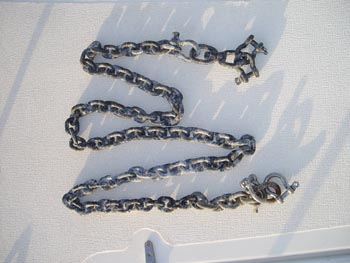 |
Web Page by Jim Faughn